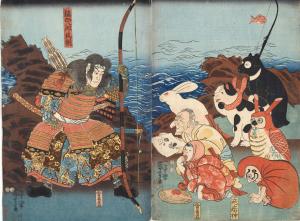Chinzei Hachirō Tametomo and the Smallpox Deity(Chinzei Hachirotametomo Hosogami)
Painted by Utagawa Kuniyoshi Tokyo Shiryō Collection 778-C18
Hōsō-e, literally "smallpox pictures," were used as charms to ward off smallpox.
This picture shows the smallpox demon and papier-mâché toys given to sick children under the demon's control, together with the hero Chinzei Hachirō Tametomo, also known as Minamoto no Tametomo. Tametomo had vanquished the smallpox demon.
Hōsō-e, literally "smallpox pictures," were used as charms to ward off smallpox. Smallpox caused more havoc in Japan than any other infectious disease, and almost everybody fell ill with the disease during childhood. Some were left with pockmarks on the skin or vision impairments, which led to the disease being known as "the illness that determines one's looks." There were no effective therapies, so people turned to prayers and incantations to fight the disease. One belief that existed in many places was that the demon of the smallpox disliked, or liked, the color red. Among other things, people kept hōsō-e pictures colored in red close at hand, and had their sick children play with toys painted red. Hōsō-e were given as get-well presents to children afflicted with smallpox, and would be burned and thrown into a river if the children recovered.
This picture shows the smallpox demon and papier-mâché toys given to sick children under the demon's control, together with the hero Chinzei Hachirō Tametomo, also known as Minamoto no Tametomo. Tametomo had been exiled to the island of Hachijō-jima after the Hōgen Rebellion, and a legend arose that there was no smallpox outbreak on the island because Tametomo had vanquished the smallpox demon. This resulted in Tametomo being used as the subject matter for hōsō-e like this one.


